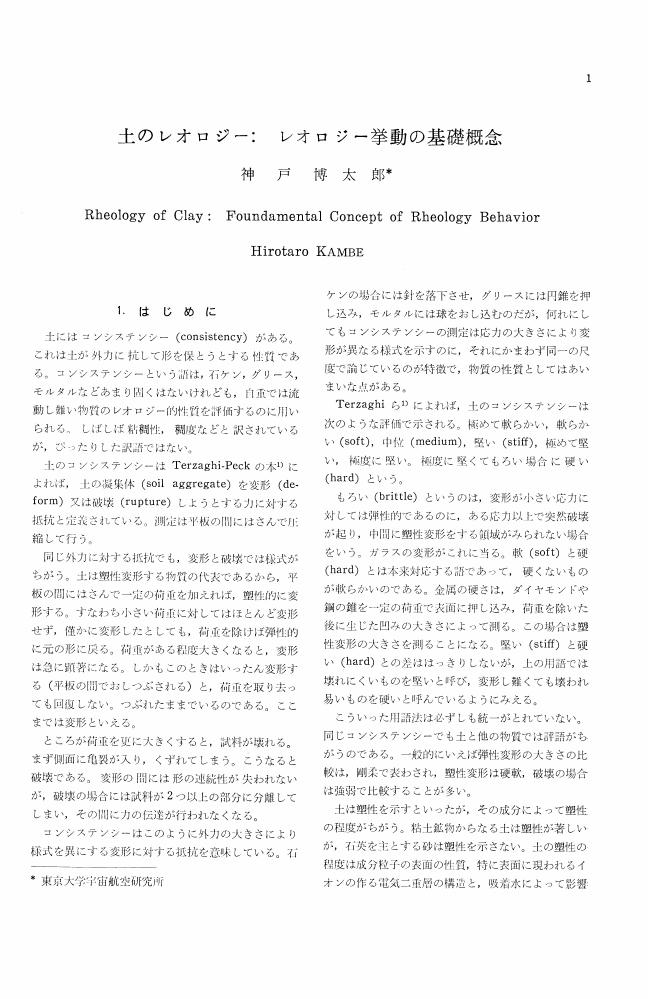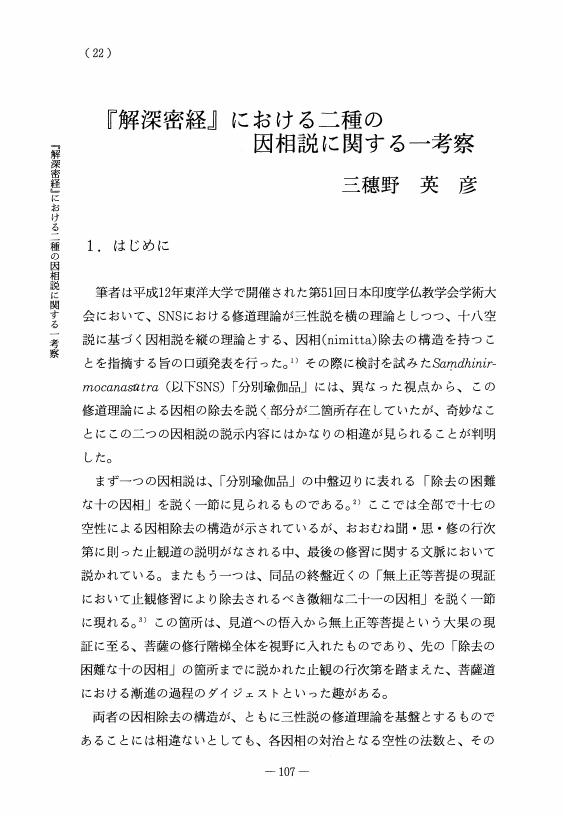- 著者
- 鴻野 わか菜
- 出版者
- 美術出版社
- 雑誌
- 美術手帖 (ISSN:02872218)
- 巻号頁・発行日
- vol.54, no.828, pp.41-60, 2002-12
1 0 0 0 IR 穢れと結界に関する一考察--「ケガレ」と「ケ」
- 著者
- 伊藤 信博
- 出版者
- 名古屋大学大学院国際言語文化研究科
- 雑誌
- 言語文化論集 (ISSN:03886824)
- 巻号頁・発行日
- vol.24, no.1, pp.3-22, 2002
1 0 0 0 穢れとその淵源
- 著者
- 米山 信
- 出版者
- 神社本庁教学研究所
- 雑誌
- 神社本庁教学研究所紀要 (ISSN:13422421)
- 巻号頁・発行日
- no.9, pp.71-97, 2004-03
1 0 0 0 仏教思想と穢れとの関係
- 著者
- 杉田 暉道
- 雑誌
- 日本醫史學雜誌 (ISSN:05493323)
- 巻号頁・発行日
- vol.55, no.4, pp.535-536, 2009-12-20
- 著者
- 鴻野 わか菜
- 出版者
- 学燈社
- 雑誌
- 別冊国文学 (ISSN:03873757)
- 巻号頁・発行日
- no.59, pp.70-72, 2005-12
1 0 0 0 非公認芸術と絵本 (特集 ロシアの絵本の魅力と日本)
- 著者
- 阿部 泰郎
- 出版者
- 日本宗教民俗学会
- 雑誌
- 宗教民俗研究 = Studies of religious folklore (ISSN:09179143)
- 巻号頁・発行日
- no.27, pp.88-101, 2017
1 0 0 0 平安時代における穢れ観念の変容--神祇祭祀からの分離
- 著者
- 尾留川 方孝
- 出版者
- 日本思想史学会
- 雑誌
- 日本思想史学 (ISSN:03865770)
- 巻号頁・発行日
- no.41, pp.56-73, 2009
1 0 0 0 OA 有時管見 : 道元の時間論とB系列の時間論
- 著者
- 護山 真也
- 出版者
- 信州大学人文学部
- 雑誌
- 信州大学人文科学論集 (ISSN:13422790)
- 巻号頁・発行日
- vol.6, pp.19-31, 2019-03-15
1 0 0 0 本邦活版開拓者の苦心
1 0 0 0 OA 土のレオロジー: レオロジー挙動の基礎概念
- 著者
- 神戸 博太郎
- 出版者
- The Clay Science Society of Japan
- 雑誌
- 粘土科学 (ISSN:04706455)
- 巻号頁・発行日
- vol.8, no.1-2, pp.1-7, 1968-08-30 (Released:2011-09-20)
- 参考文献数
- 16
1 0 0 0 OA 島根県海士町における地域づくり主体の自己生態系化プロセス
- 著者
- 佐野 淳也 Junya Sano
- 出版者
- 同志社大学政策学会
- 雑誌
- 同志社政策科学研究 = Doshisha University policy & management review (ISSN:18808336)
- 巻号頁・発行日
- vol.20, no.2, pp.13-30, 2019-03-01
島根県海士町は行財政改革と産業創出により多くのUIJターン者が移り住み、人口減少が横ばいになるなどの成果を上げた。町長や役場職員が「変革の主体」としての行動規範を伝播させるハブとなり、離島から日本を変えるという大きなミッションのもと関係人口とのネットワークを形成した。価値観やビジョンを共有しながら全体で地域イノベーションを可能にするネットワークが形成されており、それを「自己生態系化」という概念を用いて分析を行った。
1 0 0 0 OA 高齢者の健康法としての太極拳と呼吸法
- 著者
- 張 勇
- 出版者
- 日本健康行動科学会
- 雑誌
- Health and Behavior Sciences (ISSN:13480898)
- 巻号頁・発行日
- vol.2, no.2, pp.67-68, 2003 (Released:2020-08-06)
- 参考文献数
- 3
1 0 0 0 投球障害肩における肩甲骨関節窩の軌跡:機能的関節窩について
- 著者
- 村田 亮 黒田 重史 石毛 徳之 荻野 修平 三笠 元彦
- 出版者
- 日本肩関節学会
- 雑誌
- 肩関節 (ISSN:09104461)
- 巻号頁・発行日
- vol.36, no.3, pp.1015-1018, 2012 (Released:2012-10-25)
- 参考文献数
- 11
Background: The scapula rotates upwardly during shoulder elevation. If the rotation center wasn't fixed on the scapula but on the humeral head, the movement of the glenoid would be regarded as the rotation along the humeral head. We have analyzed throwing shoulder injury cases using this concept of “functional glenoid”.Methods: Patients with throwing shoulder injury (TSI group; n=22) and normal control (n=8) were included in the study. Two radiographs were taken of each subject (anteroposterior in internal rotation; IR1, zero position). Two straight lines were drawn from the superior and inferior tubercle to the center of the humeral head in IR1 image, and the angle of the lines was measured (α angle). The TSI group was divided to two groups according to slipping of the humeral head in zero position images. The difference of the glenoid inclination angles between IR1 and zero position (β angle) were then measured, and the glenoid extension ratio (α+β/α) was calculated. Each set of data was statistically evaluated.Results: In the TSI group, β angle and the glenoid extension ratio did not show significant difference compared to the control group, but the slipping-negative cases showed significantly larger β angle than slipping-positive cases and the control group.Discussion: These results may be derived from multifactorial pathology of throwing shoulder injury. Significantly large β angle in slipping-negative TSI cases may indicate an adaptive pattern of movement of the scapula. The glenoid extension ratio could not reflect the scapular kinematic change of throwing shoulder injury.
1 0 0 0 上肢 • 肩甲骨 • 骨盤運動からみた投球動作の仕組み
- 著者
- 浜田 純一郎 山口 光國 筒井 廣明 前田 健 近 良明
- 出版者
- 日本肩関節学会
- 雑誌
- 肩関節 (ISSN:09104461)
- 巻号頁・発行日
- vol.36, no.2, pp.725-729, 2012 (Released:2012-10-25)
- 参考文献数
- 6
Background: The understanding of the glenohumeral (GH) joint motion during baseball pitching should be necessary for diagnosis and treatment for throwing shoulder. The purposes of this study were firstly to investigate the motions of the scapula, pelvis, upper body, and upper limbs and secondly to speculate the motion of the GH joint and the scapula from the top position to ball release.Methods: We observed the pitching of 2 professional and 2 high-level amateurs with a digital camera and a video camera, recording each motion of the pelvis, upper body, scapula, and upper limbs. We classified pitching motion into 3 phases which were slide, upper body rotation, and arm throwing in order to simply analyze the motion in each phase.Results: Each scapula protracted and retracted respectively during pitching motion. The pelvis which was closed in the stride, ball release, and follow-through synchronized with scapular motion. The throwing arm moved in the scapular plane and made the elbow extend to the ball release. Internal rotation of the humeral head was a little from the top position to the ball release.Discussion: Both scapula and pelvis synchronized at each phase of pitching motion. The motion of the GH joint was speculated to be a small amount from the top position to ball release.
1 0 0 0 OA 古代世界におけるカシアとシナモン
- 著者
- 蔀 勇造
- 出版者
- 一般社団法人 日本オリエント学会
- 雑誌
- オリエント (ISSN:00305219)
- 巻号頁・発行日
- vol.47, no.1, pp.160-163, 2004-09-30 (Released:2010-03-12)
1 0 0 0 OA 『解深密経』における二種の因相説に関する一考察
- 著者
- 三穗野 英彦
- 出版者
- 密教研究会
- 雑誌
- 密教文化 (ISSN:02869837)
- 巻号頁・発行日
- vol.2001, no.206, pp.L22-L55, 2001-03-25 (Released:2010-03-12)
1 0 0 0 OA W. ラフルーア・G. ベーメ・島薗進編著, 『悪夢の医療史-人体実験・軍事技術・先端生命科学』, 中村圭志・秋山淑子訳, 勁草書房, 2008年(<書評特集>社会と医療をめぐる現実と歴史)
- 著者
- 宮坂 道夫
- 出版者
- 日本保健医療社会学会
- 雑誌
- 保健医療社会学論集 (ISSN:13430203)
- 巻号頁・発行日
- vol.20, no.1, pp.6-8, 2009-10-30 (Released:2016-11-16)
1 0 0 0 OA 戦争と科学者 : 「物理学者の社会的責任」第19回シンポジウム
- 著者
- 熊谷 博夫 桜井 醇児 白鳥 紀一
- 出版者
- 一般社団法人 日本物理学会
- 雑誌
- 日本物理学会誌 (ISSN:00290181)
- 巻号頁・発行日
- vol.50, no.9, pp.741-742, 1995-09-05 (Released:2019-10-09)




